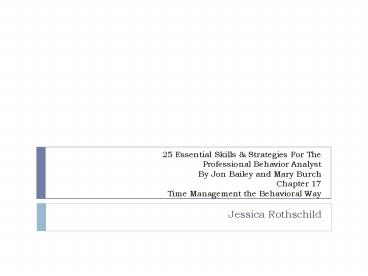25 Essential Skills - PowerPoint PPT Presentation
1 / 14
Title:
25 Essential Skills
Description:
25 Essential Skills & Strategies For The Professional Behavior Analyst By Jon Bailey and Mary Burch Chapter 17 Time Management the Behavioral Way – PowerPoint PPT presentation
Number of Views:785
Avg rating:3.0/5.0
Title: 25 Essential Skills
1
25 Essential Skills Strategies For The
Professional Behavior AnalystBy Jon Bailey and
Mary Burch Chapter 17 Time Management the
Behavioral Way
- Jessica Rothschild
2
Outline
- Reflect on a typical day.
- Identify how to waste time.
- Review a Workflow Diagram.
- Create a Self-Management Plan.
- Identify what tasks are most important to take
on. - Practice saying no.
- Summarize how to use time management skills.
3
A Day In the Life of a Behavior Analyst
Work with a teacher
Answer voice mail messages
Meeting with a principal
Answer e-mails
Rushing in order to avoid being late
Progress Reports
Have a break and maybe eat your lunch in the car
on your way to another appointment
Make Presentations
Monitor behavior plans
Keep track of billing hours
4
How To Waste Time
- Completing tasks that others can be doing.
- Solutions
- Make sure instructions are clear.
- Give plenty of examples and provide feedback with
necessary. - Behavioral erosion or slippage
- Meetings run over the designated time.
- Solution Print out general announcements and
hand them out in the beginning of the meeting. - Other ways to avoid behavioral erosion or
slippage - Improve your writing skills.
- Organize your paper work.
5
How To Waste Time
- Redoing projects.
- Do you find yourself looking back on projects or
written assessments and finding missing
information? - Solution Task analysis of your work. Could save
you up to and hour per week! - Trivial questions or invitations
- Be cautious with regard to networking.
- Solutions
- Complete your work in advance.
- Learn to say, Thank you and explain you have to
get your work done so that you can go out another
day or evening during the week. - Most importantly
- Get your work done.
- Maintain your professionalism in your decision
making.
6
The 2-minute Rule
- David Allen
- Research on personal and organizational
productivity for professionals, corporations, and
institutions. - www.davidco.com for more information about his
company, purchase products, or books. - Created a workflow diagram used to help decision
making when presented with an assignment.
7
The 2-minute Rule
In-basket
Projects (Planning)
Trash
Multistep projects
What is it?
Someday/maybe (tickler file hold for review
Is it actionable?
NO
Project plans (review for actions)
Reference (retrievable when required)
YES
Whats the next action?
Will it take less than 2 minutes
NO
YES
Do it
Delegate it
Defer it
Next actions (to do as soon as I can)
Calendar (to do at a specific time)
Waiting (for someone else to do)
8
The 2-minute Rule
- Benefits to using the workflow diagram
- Recognizes the complexity that some projects may
have. - Weekly Review
- Look at all the current projects, next actions,
delegated items, and the waiting for items. - Decreases the chances of projects being
overlooked. - Potential drawback when using Allens workflow
diagram - Assumes that task completion is a natural
reinforcer.
9
Creating a Self-Management Plan
- If you need a consequence in order to keep
plugging away. - Premack Principle
- More probable behaviors will reinforce less
probable behaviors. - Choose high probability behaviors and use them as
reinforcers for when you complete tasks that are
not naturally reinforcing. - When using self-management strategies you are
more likely to complete tasks efficiently and
reach personal goals.
10
Creating a Self-Management Plan
- Low Probability Behaviors
- High Probability Behaviors
- Doing laundry
- Make the bed
- Vacuuming and dusting
- Watch Greys Anatomy on Thursday night.
- Have company over on the weekend.
- Have my favorite breakfast.
11
Identifying Your Long-term Goal And What You Need
To Add To Your Plate To Get There
- In the beginning it is exciting!
- Identify your goal and when asked to do more
- Examine the importance of the requested task.
- Would it directly help you achieve your goal?
- If not
- Learn how to say no.
12
How To Say No
- 1. Take major caution and consideration.
- 2. Avoid offending the person making the request.
- Express appreciation for the invitation.
- Firmly express that you are unable to take on the
invitation at this time. Im sorry I cant at
this time but thank you for the invitation. - 3. Do not make up excuses.
- 4. If you are pushed to take the invitation after
professionally saying, no. - Do not give an explanation or excuse.
- Repeat your original reply staying self-assured
and objective.
13
Summary
- Being organized and having time management skills
is essential in order to have a successful career
as a behavior analyst. - If you..
- Plan your day.
- Avoid wasting time.
- Use the Premack Principle and Allens method.
- You will complete high quality work, enjoy highly
preferred activities, and have fun while doing
it!
14
References
- Bailey, J. S., Burch, M. R. (2005). Ethics for
behavior analysts A practical guide to the
behavior analyst certification board guidelines
for responsible conduct. Mahway, NJ Lawrence
Erlbaum. - Cooper, J.O., Heron,T.E., Heward, W.L. (2007).
Applied - Behavior Analysis Second Edition. Upper Saddle
River, NJ Pearson Education Inc.































